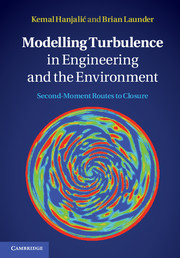Book contents
- Frontmatter
- Contents
- Preface
- Nomenclature
- 1 Introduction
- 2 The exact equations
- 3 Characterization of stress and flux dynamics: elements required for modelling
- 4 Approaches to closure
- 5 Modelling the scale-determining equations
- Chapter 6 Modelling in the immediate wall vicinity and at low Ret
- 7 Simplified schemes
- 8 Wall functions
- References
- Index
1 - Introduction
Published online by Cambridge University Press: 05 November 2012
- Frontmatter
- Contents
- Preface
- Nomenclature
- 1 Introduction
- 2 The exact equations
- 3 Characterization of stress and flux dynamics: elements required for modelling
- 4 Approaches to closure
- 5 Modelling the scale-determining equations
- Chapter 6 Modelling in the immediate wall vicinity and at low Ret
- 7 Simplified schemes
- 8 Wall functions
- References
- Index
Summary
The fact of turbulent flow
Man has evolved within a world where air and water are, by far, the most common fluids encountered. The scales of the environment around him and of the machines and artefacts his ingenuity has created mean that, given their relatively low kinematic viscosities, the relevant global Reynolds number, Re, associated with the motion of both fluids is, in most cases, sufficiently high that the resultant flow is of the continually time-varying, spatially irregular kind we call turbulent.
If, however, our Reynolds number is chosen not by the overall physical dimension of the body of interest – an aircraft wing, say – and the fluid velocity past it but by the smallest distance over which the velocity found within a turbulent eddy changes appreciably and the time over which such a velocity change will occur, its value then turns out to be of order unity. Indeed, one might observe that if this last Reynolds number, traditionally called the micro-scale Reynolds number, Reη, were significantly greater than unity, the rate at which the turbulent kinetic energy is destroyed by viscous dissipation could not balance the overall rate at which turbulence ‘captures’ kinetic energy from the mean flow.
- Type
- Chapter
- Information
- Modelling Turbulence in Engineering and the EnvironmentSecond-Moment Routes to Closure, pp. 1 - 12Publisher: Cambridge University PressPrint publication year: 2011

